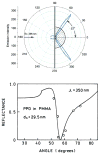Surface Plasmon-Coupled Ultraviolet Emission of 2,5-Diphenyl-1,3,4-oxadiazole
- PMID: 20725614
- PMCID: PMC2923458
- DOI: 10.1021/jp047136u
Surface Plasmon-Coupled Ultraviolet Emission of 2,5-Diphenyl-1,3,4-oxadiazole
Abstract
We studied surface plasmon-coupled emission (SPCE) of 2,5-diphenyl-1,3,4-oxadiazole (PPD) using a 20 nm aluminum film deposited on a quartz substrate. The directional SPCE UV fluorescence occurs within a narrow angle at 57° from the normal to the coupling hemicylindrical prism. This radiation is almost completely p-polarized, consistent with its origin from surface plasmons. These surface plasmons are induced by excited PPD molecules. The coupling of excited fluorophore dipoles with the aluminum is highly efficient, exceeding 50%. Different fluorescence emission wavelengths are emitted at slightly different angles on the prism, providing intrinsic spectral resolution. SPCE fluorescence on thin aluminum films can be used with many UV absorbing and emitting fluorophores.
Figures








Similar articles
-
Ultraviolet surface plasmon-coupled emission using thin aluminum films.Anal Chem. 2004 Jul 15;76(14):4076-81. doi: 10.1021/ac040004c. Anal Chem. 2004. PMID: 15253645 Free PMC article.
-
Surface plasmon-coupled polarized emission of N-acetyl-l-tryptophanamide.Photochem Photobiol. 2004 Nov-Dec;80(3):482-5. doi: 10.1562/0031-8655(2004)080<0482:SPPEON>2.0.CO;2. Photochem Photobiol. 2004. PMID: 15623334 Free PMC article.
-
Plasmon- and Waveguide-Coupled Fluorescence at the Ultraviolet Region.J Phys Chem C Nanomater Interfaces. 2023 Jun 29;127(25):12084-12095. doi: 10.1021/acs.jpcc.3c01231. Epub 2023 Jun 20. J Phys Chem C Nanomater Interfaces. 2023. PMID: 38274198 Free PMC article.
-
Surface plasmon-coupled emission: what can directional fluorescence bring to the analytical sciences?Annu Rev Anal Chem (Palo Alto Calif). 2012;5:317-36. doi: 10.1146/annurev-anchem-062011-143208. Epub 2012 Apr 9. Annu Rev Anal Chem (Palo Alto Calif). 2012. PMID: 22524220 Review.
-
Plasmonic technology: novel approach to ultrasensitive immunoassays.Clin Chem. 2005 Oct;51(10):1914-22. doi: 10.1373/clinchem.2005.053199. Epub 2005 Jul 28. Clin Chem. 2005. PMID: 16055432 Free PMC article. Review.
Cited by
-
Plasmon-controlled fluorescence: A new detection technology.Proc SPIE Int Soc Opt Eng. 2006;6099:609909. doi: 10.1117/12.673106. Proc SPIE Int Soc Opt Eng. 2006. PMID: 20953312 Free PMC article.
-
Detecting and differentiating neurotransmitters using ultraviolet plasmonic engineered native fluorescence.RSC Adv. 2023 Nov 7;13(46):32582-32588. doi: 10.1039/d3ra05405e. eCollection 2023 Oct 31. RSC Adv. 2023. PMID: 37942452 Free PMC article.
-
Application of surface plasmon coupled emission to study of muscle.Biophys J. 2006 Oct 1;91(7):2626-35. doi: 10.1529/biophysj.106.088369. Epub 2006 Jul 14. Biophys J. 2006. PMID: 16844757 Free PMC article.
-
Bloch Surface Wave-Coupled Emission at Ultra-Violet Wavelengths.J Phys Chem C Nanomater Interfaces. 2016 Dec 22;120(50):28727-28734. doi: 10.1021/acs.jpcc.6b08086. Epub 2016 Nov 23. J Phys Chem C Nanomater Interfaces. 2016. PMID: 28725334 Free PMC article.
-
Feasibility of Using Bimetallic Plasmonic Nanostructures to Enhance the Intrinsic Emission of Biomolecules.J Phys Chem C Nanomater Interfaces. 2011 Sep 1;115(34):16879-16891. doi: 10.1021/jp205108s. J Phys Chem C Nanomater Interfaces. 2011. PMID: 21984954 Free PMC article.
References
-
- Liedberg B, Lundstrom I. Principles of biosensing with an extended coupling matrix and surface plasmon resonance. Sens Actuators, B. 1993;11:63–72.
-
- Frey BL, Jordan CE, Kornguth S, Corn RM. Control of the specific adsorption of proteins onto gold surface with poly(L-lysine) monolayers. Anal Chem. 1995;67:4452–4457.
-
- Salamon Z, Macleod HA, Tollin G. Surface plasmon resonance spectroscopy as a tool for investigating the biochemical and biophysical properties of membrane protein systems. I: Theoretical principles. Biochim Biophys Acta. 1997;1331:117–129. - PubMed
-
- Liebermann T, Knoll W. Surface plasmon field-enhanced fluorescence spectroscopy. Colloid Surf. 2000;171:115–130.
Grants and funding
LinkOut - more resources
Full Text Sources
